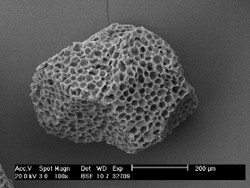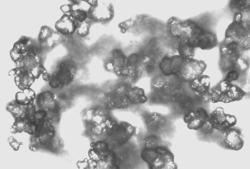Functionalized UHMW PE Microparticles and porous PP particles
PolyAn offers functionalized porous, homopolymer polypropylene particles as powder resp. granules*). These particles are mechanically stable, chemically inert and low swelling in most organic solvents (illustration: SEM Micrograph of an Accurel® MP1000 Particle).
Characteristics of porous PP microparticles:
| MFR PP: | 25 g/10 min (ISO 1133 @ 230°C/2,16kg) |
| Density: | 0,9 g/cm³ |
| Melting Temperature: | 156° C |
| Void content: | 73% |
Due to the completely open cell structure the porous polypropylene particles act like tiny sponges with the capability to absorb several times their own weight of liquid substances. When functionalized these particles remain dry and free-flowing and therefore convenient to dose and to handle.

Additionally, PolyAn also offers functionalised UHMW Polyethylene (PE) microparticles with a diameter of 30µm (illustration: 40x microscope image of UHMW PE microparticles).
PolyAn functionalizes the internal and external surfaces of both the porous PP microparticles and the UHWM PE microparticles with either 3D-Amino or 3D-Carboxy matrices, suitable for coupling biomolecules or catalysts.
Applications
The functionalized, porous particles are also suitable for solid phase synthesis and flow chemistry applications, e.g.:
- Covalent immobilization of enzymes
- Covalent immobilization of catalysts
- Use as scavenger particles to separate specific molecules resp. molecule classes from a product stream
- Reactive agents

Products
3D-Carboxy Functionalized Porous Polypropylene Microparticles
| Id | 200 02 400 |
| Title | 3D-Carboxy Functionalized Porous Polypropylene Microparticles |
| Substrate | Polypropylene |
| Format | Porous Polypropylene (PP) |
| Mean Diameter | 400 µm µm |
| Color Labeling | |
| Surface Modifications | 3D-Carboxy |
| Solids Content | |
| Product Dimensions | |
| Packaging | Dry powder |
| Packaging Volume | 5 mg |
| Package Weight | |
| Dimensions | |
| Hts Code | |
| Pads Wells | |
| Pad Size | |
| Well Format | |
| Product Thickness | |
| Description | Functionalized porous polypropylene particles as powder resp. granules. The microparticles are equipped with a 3D-Carboxy Matrix for non-covalent coupling (immobilization) of positively charged biochemical species (compounds) via electrostatic adsorption. The 3D-Carboxy matrix is equipped with an incorporated antifouling matrix which reduces unspecific binding. |
| Image |
Please do not hesitate to contact us, if you are looking for a mechanically and chemically support for immobilising your catalyst, enzyme or active compound.
